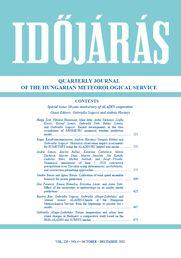Időjárás - Quarterly Journal of the Hungarian Meteorological Service (OMSZ)
Vol. 125, No. 4 * Pages 521–692 * October - December 2021
 |
Special issue: 30-year anniversary of ALADIN cooperation |
 download [pdf: 4949 KB]
download [pdf: 4949 KB]
Recent developments in the data assimilation of AROME/HU numerical weather prediction model
Helga Tóth, Viktória Homonnai, Máté Mile, Anikó Várkonyi, Zsófia Kocsis, Kristóf Szanyi, Gabriella Tóth, Balázs Szintai, and Gabriella Szépszó
DOI:10.28974/idojaras.2021.4.1 (pp. 521–553)
Helga Tóth, Viktória Homonnai, Máté Mile, Anikó Várkonyi, Zsófia Kocsis, Kristóf Szanyi, Gabriella Tóth, Balázs Szintai, and Gabriella Szépszó
DOI:10.28974/idojaras.2021.4.1 (pp. 521–553)
Historical observation impact assessments for EUMETNET using the ALADIN/HU limited area model
Roger Randriamampianina, András Horányi, Gergely Bölöni, and Gabriella Szépszó
DOI:10.28974/idojaras.2021.4.2 (pp. 555–570)
Roger Randriamampianina, András Horányi, Gergely Bölöni, and Gabriella Szépszó
DOI:10.28974/idojaras.2021.4.2 (pp. 555–570)
Numerical simulations of June 7, 2020 convective precipitation over Slovakia using deterministic, probabilistic, and convection-permitting approaches
André Simon, Martin Belluš, Katarína Čatlošová, Mária Derková, Martin Dian, Martin Imrišek, Ján Kaňák, Ladislav Méri, Michal Neštiak and Jozef Vivoda
DOI:10.28974/idojaras.2021.4.3 (pp. 571–607)
André Simon, Martin Belluš, Katarína Čatlošová, Mária Derková, Martin Dian, Martin Imrišek, Ján Kaňák, Ladislav Méri, Michal Neštiak and Jozef Vivoda
DOI:10.28974/idojaras.2021.4.3 (pp. 571–607)
Calibration of wind speed ensemble forecasts for power generation
Sándor Baran and Ágnes Baran
DOI:10.28974/idojaras.2021.4.4 (pp. 609–624)
Sándor Baran and Ágnes Baran
DOI:10.28974/idojaras.2021.4.4 (pp. 609–624)
Effect of the uncertainty in meteorology on air quality model predictions
Zita Ferenczi, Emese Homolya, Krisztina Lázár, and Anita Tóth
DOI:10.28974/idojaras.2021.4.5 (pp. 625–646)
Zita Ferenczi, Emese Homolya, Krisztina Lázár, and Anita Tóth
DOI:10.28974/idojaras.2021.4.5 (pp. 625–646)
ALADIN-Climate at the Hungarian Meteorological Service: from the beginnings to the present day’s results
Beatrix Bán, Gabriella Szépszó, Gabriella Allaga-Zsebeházi, and Samuel Somot
DOI:10.28974/idojaras.2021.4.6 (pp. 647–673)
Beatrix Bán, Gabriella Szépszó, Gabriella Allaga-Zsebeházi, and Samuel Somot
DOI:10.28974/idojaras.2021.4.6 (pp. 647–673)
Future temperature and urban heat island changes in Budapest: a comparative study based on the HMS-ALADIN and SURFEX models
Gabriella Allaga-Zsebeházi
DOI:10.28974/idojaras.2021.4.7 (pp. 675–692)
Gabriella Allaga-Zsebeházi
DOI:10.28974/idojaras.2021.4.7 (pp. 675–692)
IDŐJÁRÁS - Quarterly Journal

Az IDŐJÁRÁS a HungaroMet Nonprofit Zrt. negyedévenként megjelenő angol nyelvű folyóirata
Megrendelhető a journal.idojaras@met.hu címen.
A szerzőknek szánt útmutató itt olvasható.
Megrendelhető a journal.idojaras@met.hu címen.
A szerzőknek szánt útmutató itt olvasható.









